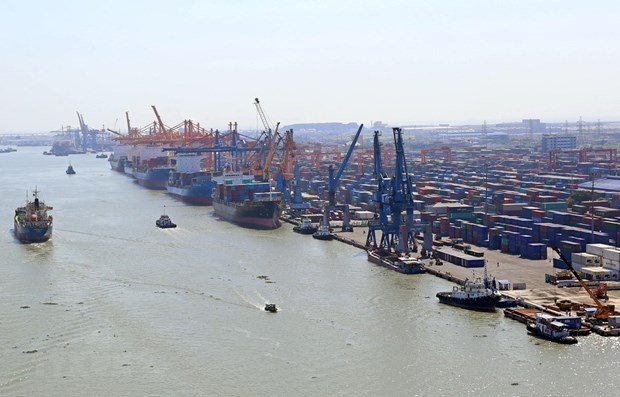Maritime transport key to Vietnam’s sea strategy
Vietnam has paid due attention to the development of maritime transport, which is seen as a spearheaded sector in the country’s sea development strategy.
 Maritime transport is seen as a spearheaded sector in the country’s sea development strategy. (Photo: VNA)
Maritime transport is seen as a spearheaded sector in the country’s sea development strategy. (Photo: VNA)Hanoi (VNA) – Vietnam has paid due attention to the development of maritime transport, which is seen as a spearheaded sector in the country’s sea development strategy.
According to the Vietnam Maritime Administration, the country had a fleet of nearly 1,600 ships by the end of 2018, which can handle 144.5 million tonnes of cargo in the year, accounting for 55.6 percent of the total goods circulated.
The vessels are now undertaking nearly 100 percent of domestic sea shipping of food, coal, building materials, machines, and oil and gas. However, except for several bulk carriers which carry goods to the Europe, Vietnam’s sea-going ships now mainly run on short-haul routes like Southeast and Northeast Asia as there are only 42 containers ships, accounting for 3.6 percent of the total vessels.
Under the Ministry of Transport’s project to restructure maritime transport, the capacity of Vietnam’s fleet will be expanded to 6.8-7.5 million dead weight tonnes (DWT) by 2020. The ships will be modernised to enhance the country’s share in the transport market.
Maritime shipping contributed to increasing the country’s import-export transport by 25-30 percent in the past years. By 2020, the fleet is envisioned to command 21.25 percent of the total goods, and 0.07 percent of the passengers in the country.
Heavy investments have been poured into this kind of transport, with a wide range of infrastructure having been completed such as Lach Huyen-Hai Phong port which can welcome 100,000-tonne ships, and Cai Mep Thi Vai port in Ba Ria-Vung Tau province which is designed to host the most modern container ships. Besides, upgrade and investment have been made to most of the sea ports in the country across 2011-2018 so that they are now able to welcome large ships with capacities from 10,000 tonnes.
At the same time, many international passenger ports were invested in Quang Ninh province and Phu Quoc island in Kien Giang province while specialised ports for industrial parks like Nghi Son, Vung Ang, Dung Quat and Vinh Tan have been put into operation, helping to attract investment and bolster the economy of coastal localities.
According to Doctor Trinh The Cuong from the Vietnam Maritime Administration, a comprehensive development of sea port system is necessary to meet the country’s industrialisation and modernisation, laying foundation for the country to better integrate into the global economy as well as gaining competitive edge in sea transport over regional and global players in the field.
He said that the move also helps affirm the key role of the sea-based economy while making contributions to ensuring national defence and security.
In 2007, the 10th Party Central Committee adopted Vietnam’s Maritime Strategy towards 2020 to further enhance a sea-based economy and safeguarding national sovereignty over islands and seas. The strategy set out a goal that sea-based economic sectors will make up 53-55 per cent of the country’s gross domestic product (GDP) while the per capita income in the coastal areas is expected to double the average of the whole country by 2020.
The 12th Party Central Committee’s Resolution No.36/NQ-TW dated October 22, 2018, outlined several breakthroughs for sustainable sea-based economic development until 2030, with vision until 2045, prioritising tourism and maritime services, maritime economy, exploitation of gas and sea resources, seafood aquaculture, and industrial development in coastal areas, among others.-VNA













